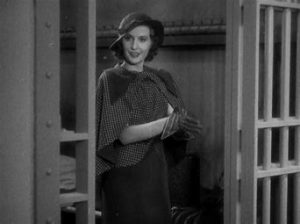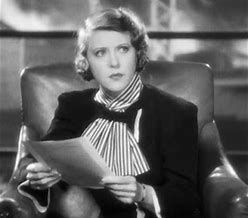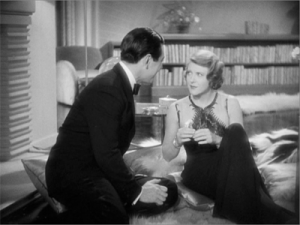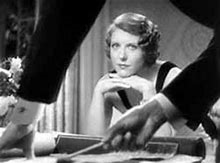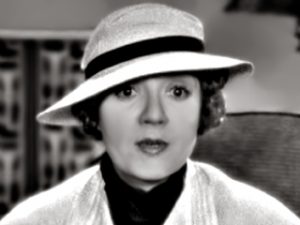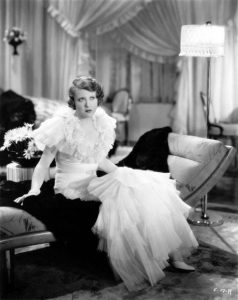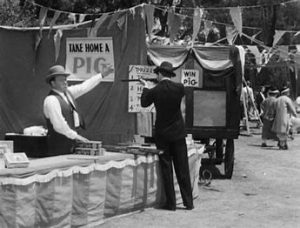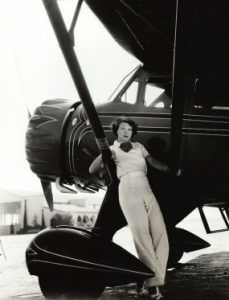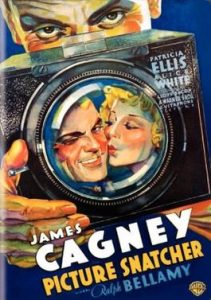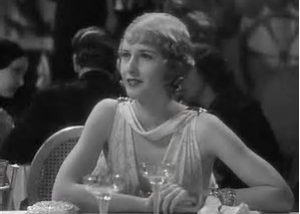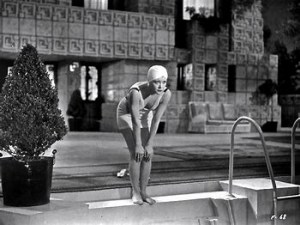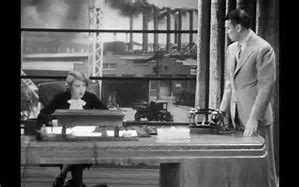Our discussion after viewing the uncensored (discovered in 2004) version of Baby Face (1933, Alfred Green) focused on several areas. These included its heroine Lily (Barbara Stanwyck), comparison and contrasts to heroines (and female stars) of other pre-code films such as Red-Headed Woman and Rain, Lily’s relationships with men (especially Courtland Trenholm, played by George Brent), the film’s writers, and differences between the censored and uncensored versions of the films.
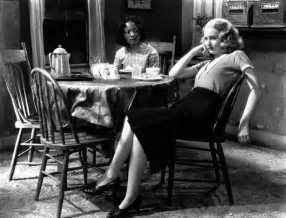 One of the first remarks when we finished viewing the film, concerned the efficiency of Lily’s (Barbara Stanwyck’s) rise to the top. We commented on the effective visual way in which her speedy sexual conquest of all men she met was conveyed. This is notable in terms of Lily ascending the floors of the Gotham Trust Tower as she improves her career prospects by sleeping with the bosses of each department. Lily’s accommodation also progresses. She moves from the tacky bar in Pennsylvania in which she grew up to cheap rooms in New York. While Lily is working, she is shown incongruously living in more palatial apartment with a stunning staircase, maid (her friend Chico) and butler, and ends the film as a married woman living in the company penthouse.
One of the first remarks when we finished viewing the film, concerned the efficiency of Lily’s (Barbara Stanwyck’s) rise to the top. We commented on the effective visual way in which her speedy sexual conquest of all men she met was conveyed. This is notable in terms of Lily ascending the floors of the Gotham Trust Tower as she improves her career prospects by sleeping with the bosses of each department. Lily’s accommodation also progresses. She moves from the tacky bar in Pennsylvania in which she grew up to cheap rooms in New York. While Lily is working, she is shown incongruously living in more palatial apartment with a stunning staircase, maid (her friend Chico) and butler, and ends the film as a married woman living in the company penthouse.
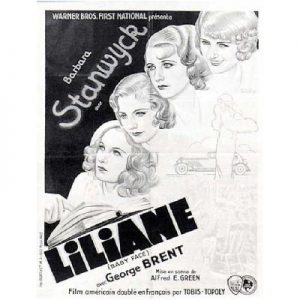 Changes to Lily’s person also comment on her rise in social position. Her earlier fussy clothes and hairstyling give way to sleeker and more sophisticated fashions. Like Lily’s acquisition of a maid and butler, this can also be connected to her concern with ‘etiquette’ – the title of a book she is seen to be reading at her work desk. A poster for the film demonstrates Lily’s changing fashions, with the placement of an open book in the bottom of the left-hand corner suggesting such this has caused Lily’s transformations.
Changes to Lily’s person also comment on her rise in social position. Her earlier fussy clothes and hairstyling give way to sleeker and more sophisticated fashions. Like Lily’s acquisition of a maid and butler, this can also be connected to her concern with ‘etiquette’ – the title of a book she is seen to be reading at her work desk. A poster for the film demonstrates Lily’s changing fashions, with the placement of an open book in the bottom of the left-hand corner suggesting such this has caused Lily’s transformations.
 The fact that Lily’s progresses upwards, rather than spiralling downwards, comments on the fact she is a ‘bad girl’ trying to improve her situation, rather than a ‘fallen woman’. We particularly connected this to melodrama, as we compared Lily to the ‘classic’ suffering heroine in melodrama (for example, Lillian Gish in Way Down East (1920)) who despairs at her fate after an often blameless fall from grace. Lily has certainly suffered – the film spends a reasonable amount of time documenting her early life as a justification for her later actions – as it is made clear that her father has prostituted her from a young age. Yet her attitude is detached. In scenes near the beginning of the film, she calmly responds to an older man’s sexual advances with what seem to be well-worn behaviours: pouring scalding coffee over his legs, and smashing a bottle over his head.
The fact that Lily’s progresses upwards, rather than spiralling downwards, comments on the fact she is a ‘bad girl’ trying to improve her situation, rather than a ‘fallen woman’. We particularly connected this to melodrama, as we compared Lily to the ‘classic’ suffering heroine in melodrama (for example, Lillian Gish in Way Down East (1920)) who despairs at her fate after an often blameless fall from grace. Lily has certainly suffered – the film spends a reasonable amount of time documenting her early life as a justification for her later actions – as it is made clear that her father has prostituted her from a young age. Yet her attitude is detached. In scenes near the beginning of the film, she calmly responds to an older man’s sexual advances with what seem to be well-worn behaviours: pouring scalding coffee over his legs, and smashing a bottle over his head.
 Lily’s emotional detachment continues, even in the most melodramatic of situations. Her previous paramour Ned Stevens (Donald Cook) shoots dead her latest lover J.R. Carter (Henry Kolker) (coincidentally also until recently Stevens’ prospective father-in-law as well as his boss) before turning the gun on himself in her apartment. Initially Lily seems unsure what to do, but she soon turns pragmatic as she calmly telephones for the police to be called. Most of Lily’s responses which we can interpret as emotional – turning away, raising a handkerchief to her face and inserting a break into her voice – occur when she is caught in a compromising situation with a man by another man. Lily is unconcerned by the fate of the man she accuses of being her seducer, as she is more concerned with hoodwinking the man who has discovered the pair, lining him up as her next lover.
Lily’s emotional detachment continues, even in the most melodramatic of situations. Her previous paramour Ned Stevens (Donald Cook) shoots dead her latest lover J.R. Carter (Henry Kolker) (coincidentally also until recently Stevens’ prospective father-in-law as well as his boss) before turning the gun on himself in her apartment. Initially Lily seems unsure what to do, but she soon turns pragmatic as she calmly telephones for the police to be called. Most of Lily’s responses which we can interpret as emotional – turning away, raising a handkerchief to her face and inserting a break into her voice – occur when she is caught in a compromising situation with a man by another man. Lily is unconcerned by the fate of the man she accuses of being her seducer, as she is more concerned with hoodwinking the man who has discovered the pair, lining him up as her next lover.
 These consistently faked emotional responses are perhaps partly what makes the end of the film less than convincing. By this time, Lily has made it to the top of the ladder. She now occupies the company penthouse with her husband the company’s president, Courtland Trenholm (George Brent). After a while of living the high life and gathering money and jewels, the bank is in crisis, and Lily’s husband is threatened with indictment. After initially deserting her husband, Lily changes her mind not to provide the money necessary for his bail. She returns to their penthouse, only to find him near to death after attempting to take his own life. Lily rushes to him, calls his name, and visible appears upset. Her frantic calling for an ambulance notably contrasts to her earlier emotionless request for the police to attend the murder and suicide at her apartment. Although the group did not find Lily’s change of heart credible, unlike the earlier situations in which Lily affects emotion, and we the audience is privy to Lily’s manipulation, it is signalled to be ‘real’. Not only has Lily already decided to return to her desperate husband, but her concern for him extends to her behaviour in the ambulance, when she does not care that she has dropped her case of jewels on the floor.
These consistently faked emotional responses are perhaps partly what makes the end of the film less than convincing. By this time, Lily has made it to the top of the ladder. She now occupies the company penthouse with her husband the company’s president, Courtland Trenholm (George Brent). After a while of living the high life and gathering money and jewels, the bank is in crisis, and Lily’s husband is threatened with indictment. After initially deserting her husband, Lily changes her mind not to provide the money necessary for his bail. She returns to their penthouse, only to find him near to death after attempting to take his own life. Lily rushes to him, calls his name, and visible appears upset. Her frantic calling for an ambulance notably contrasts to her earlier emotionless request for the police to attend the murder and suicide at her apartment. Although the group did not find Lily’s change of heart credible, unlike the earlier situations in which Lily affects emotion, and we the audience is privy to Lily’s manipulation, it is signalled to be ‘real’. Not only has Lily already decided to return to her desperate husband, but her concern for him extends to her behaviour in the ambulance, when she does not care that she has dropped her case of jewels on the floor.
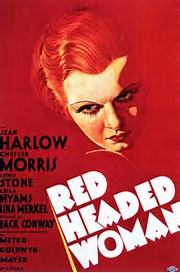 We thought that another reason we found Lily’s return to her husband unconvincing, was that we were not given much time to invest in their relationship. Trenholm enters the narrative quite late and his and Lily’s relationship does not gradually develop. This is because her climb up the ladder involves using many men to step up to the next level – and this leaves little time. We compared this to the situation in other contemporaneous ‘bad girl’ films. In Red Headed Woman (1932), Lillian (Jean Harlow) marries a man after wrecking his first marriage. She then cheats on him with a business associate and the business associate’s chauffeur, and finally shoots her estranged husband. She does not appear to be punished by the narrative as her husband refuses to press charges, and the fact that she is seen with an older man later in film suggests that she has found someone else to take care of her. This summary of the plot, though brief, illuminates some key difference between Lillian and Lily. While Lillian seduces and marries a man at the beginning of the film, Lily only marries towards the film’s end. This suggests that Lily develops, while Lillian does not, and that Lily is indeed more contained by the narrative which sees her living within social norms at the film’s close.
We thought that another reason we found Lily’s return to her husband unconvincing, was that we were not given much time to invest in their relationship. Trenholm enters the narrative quite late and his and Lily’s relationship does not gradually develop. This is because her climb up the ladder involves using many men to step up to the next level – and this leaves little time. We compared this to the situation in other contemporaneous ‘bad girl’ films. In Red Headed Woman (1932), Lillian (Jean Harlow) marries a man after wrecking his first marriage. She then cheats on him with a business associate and the business associate’s chauffeur, and finally shoots her estranged husband. She does not appear to be punished by the narrative as her husband refuses to press charges, and the fact that she is seen with an older man later in film suggests that she has found someone else to take care of her. This summary of the plot, though brief, illuminates some key difference between Lillian and Lily. While Lillian seduces and marries a man at the beginning of the film, Lily only marries towards the film’s end. This suggests that Lily develops, while Lillian does not, and that Lily is indeed more contained by the narrative which sees her living within social norms at the film’s close.
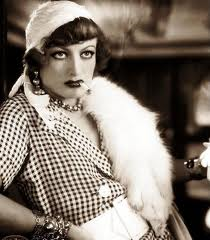 Neither Lily nor Lillian are straightforward with the men with whom they have relationships, and comparison to another film – Rain (1932) – provides further insight. In this adaption of Somerset Maugham’s short story, the costuming and acting of Joan Crawford depicts Sadie as a woman who does not hide the fact that she is working as a prostitute, and as such is more honest and less manipulative than Lily and Lillian. We briefly compared the growth of Lily and Sadie. Lily’s transformation is gradual in dress and hairstyling, and with an upwards trajectory, until the final realisation which the audience may or may not choose to believe. After some time, Sadie changes overnight from a brash, heavily jewelled and carefully coiffured
Neither Lily nor Lillian are straightforward with the men with whom they have relationships, and comparison to another film – Rain (1932) – provides further insight. In this adaption of Somerset Maugham’s short story, the costuming and acting of Joan Crawford depicts Sadie as a woman who does not hide the fact that she is working as a prostitute, and as such is more honest and less manipulative than Lily and Lillian. We briefly compared the growth of Lily and Sadie. Lily’s transformation is gradual in dress and hairstyling, and with an upwards trajectory, until the final realisation which the audience may or may not choose to believe. After some time, Sadie changes overnight from a brash, heavily jewelled and carefully coiffured 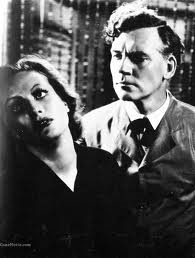 woman to one dressing in drab dark clothes, with simply-styled hair, and quieter gestures. The fact this is presented with almost religious overtones and is a set-piece of the film, affords it more weight in terms of character development than Lily’s. Like Lily, Sadie too is contained within an acceptable monogamous relationship at the film’s conclusion. (For more on Rain, please see our previous discussion here: http://blogs.kent.ac.uk/melodramaresearchgroup/2013/10/20/summary-of-discussion-on-rain/)
woman to one dressing in drab dark clothes, with simply-styled hair, and quieter gestures. The fact this is presented with almost religious overtones and is a set-piece of the film, affords it more weight in terms of character development than Lily’s. Like Lily, Sadie too is contained within an acceptable monogamous relationship at the film’s conclusion. (For more on Rain, please see our previous discussion here: http://blogs.kent.ac.uk/melodramaresearchgroup/2013/10/20/summary-of-discussion-on-rain/)
We wondered whether Crawford would have been as successful as Stanwyck at depicting a heroine who manipulated many men, but also retained audience sympathy. It was thought unlikely that Crawford would have been able to convey the sense of feigned innocence as effectively as Stanwyck. Reference to some fan and trade magazines Lies has kindly posted on our sister blog, NoRMMA, suggest that Stanywck was thought especially suitable for the role. Picture Play’s September 1933 review of the film praises Stanwyck as ‘thoughtfully convincing’, eschewing ‘the histrionic splurge of a star on the rampage’ (p. 70). (You can find Lies’ posts here: http://www.normmanetwork.com/?p=614) It is notable that Crawford was not a critical success in Rain.
of a star on the rampage’ (p. 70). (You can find Lies’ posts here: http://www.normmanetwork.com/?p=614) It is notable that Crawford was not a critical success in Rain.
 We also thought that Stanwyck was a particularly effective choice. During much of the film, Lily insists on carrying on with her career and this fitted well with Stanwyck’s star image as a hard-working and no-nonsense star. After breaking up Ned Stevens’ engagement, Lily refuses his offer to look after her, stating that she wants to continue working. This was hugely relevant to female stars of the day who, unlike their male counterparts, were asked if they would continue working after they married.
We also thought that Stanwyck was a particularly effective choice. During much of the film, Lily insists on carrying on with her career and this fitted well with Stanwyck’s star image as a hard-working and no-nonsense star. After breaking up Ned Stevens’ engagement, Lily refuses his offer to look after her, stating that she wants to continue working. This was hugely relevant to female stars of the day who, unlike their male counterparts, were asked if they would continue working after they married.
 We focused a little more on the film’s male characters. After manipulating so many stupid men, we initially thought that Lily had finally met her match (in both senses) with Trenholm. But he too disappoints us. He thwarts her attempt to extort money from the company by taking her at her dishonest word that she is not interested in money for her diaries (the publication of which would be explosive for the bank) but about having another chance. Lily takes up his offer of a job in their Paris office, succeeding in her new post and not turning to men for financial support. When Trenholm visits Paris, Lily contrives to take a ride with him in his car and they strike up conversation. She seemingly candidly admits that she only took the job and led a quiet life to prove him wrong. It takes just a few days, the ‘happiest’ of his life, and her clearly leading mention of marriage (she says she would like the title ‘Mrs’ on her tombstone), for him to propose. Following their marriage, Lily disappoints us too – she gives up the career she earlier insisted on keeping.
We focused a little more on the film’s male characters. After manipulating so many stupid men, we initially thought that Lily had finally met her match (in both senses) with Trenholm. But he too disappoints us. He thwarts her attempt to extort money from the company by taking her at her dishonest word that she is not interested in money for her diaries (the publication of which would be explosive for the bank) but about having another chance. Lily takes up his offer of a job in their Paris office, succeeding in her new post and not turning to men for financial support. When Trenholm visits Paris, Lily contrives to take a ride with him in his car and they strike up conversation. She seemingly candidly admits that she only took the job and led a quiet life to prove him wrong. It takes just a few days, the ‘happiest’ of his life, and her clearly leading mention of marriage (she says she would like the title ‘Mrs’ on her tombstone), for him to propose. Following their marriage, Lily disappoints us too – she gives up the career she earlier insisted on keeping.
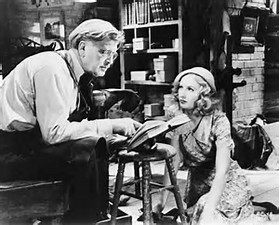 The only man who is not shown in a poor light is the cobbler, Adolf Cragg (Alphonse Athier) who recommends Lily follows Nietzsche’s philosophy. When he arrives at the bar, Lily seeks him out, telling him he is different to other men. Lily later visits him for advice after her father dies, and she continues to receive lessons in philosophy from him by post. It is notable that this lone positive view of a man is of the only non-American man playing a significant role. We could also argue that this gives an element of detachment to his advice. He is advocating cynical European philosophy rather than a more obviously optimistic ‘American’ way of life.
The only man who is not shown in a poor light is the cobbler, Adolf Cragg (Alphonse Athier) who recommends Lily follows Nietzsche’s philosophy. When he arrives at the bar, Lily seeks him out, telling him he is different to other men. Lily later visits him for advice after her father dies, and she continues to receive lessons in philosophy from him by post. It is notable that this lone positive view of a man is of the only non-American man playing a significant role. We could also argue that this gives an element of detachment to his advice. He is advocating cynical European philosophy rather than a more obviously optimistic ‘American’ way of life.
It was interesting to consider the source of the film – whether it was an adaptation of an existing text or an original screenplay. We especially connected this to the obvious way in which the film would have challenged censors of the day, even before the Production Code came into force in 1934. In some ways it seemed almost taunting in its almost conveyor belt style production line of men in Lily’s life. The story was provided, under a pseudonym, by Daryl F. Zanuck – head of Production at Warner Bros. Given that Zanuck would have had particular insight into the threat of industry censorship, this seemed a brave move when the industry was attempting to keep censorship 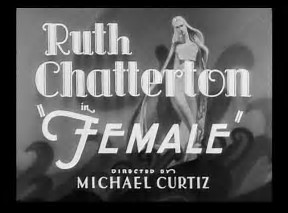 a more ‘in-house’ matter. While Zanuck wrote the framework of the story (presumably the main plot line of Lily working her way up the ladder), some of the more nuanced aspects which intervene in the matter of career are perhaps attributable to the screenwriters Gene Markey and Kathryn Scola. The pair also worked together on the films Female and Midnight Mary, both released the same year as Baby Face.
a more ‘in-house’ matter. While Zanuck wrote the framework of the story (presumably the main plot line of Lily working her way up the ladder), some of the more nuanced aspects which intervene in the matter of career are perhaps attributable to the screenwriters Gene Markey and Kathryn Scola. The pair also worked together on the films Female and Midnight Mary, both released the same year as Baby Face.
 Scola was one of several female screenwriters who worked on such films at the time. Others included Anita Loos (who began work on Midnight Mary before it was passed to Markey and Scola), and Ursula Parrot who wrote the novel The Divorcee (1930) is based on (you can see our discussion of the film here: http://blogs.kent.ac.uk/melodramaresearchgroup/2013/02/28/a-summary-of-discussion-on-the-divorcee/) While we cannot presume that Scola was responsible for the aspects which seemed especially progressive for women (such as Lily’s insistence on her career), it is also the case that while there is a certain applauding of Lily turning the tables on men who have abused her, this is not uncomplicated. We may see this as a form of feminism today, but it is difficult to know what the intent as at the time.
Scola was one of several female screenwriters who worked on such films at the time. Others included Anita Loos (who began work on Midnight Mary before it was passed to Markey and Scola), and Ursula Parrot who wrote the novel The Divorcee (1930) is based on (you can see our discussion of the film here: http://blogs.kent.ac.uk/melodramaresearchgroup/2013/02/28/a-summary-of-discussion-on-the-divorcee/) While we cannot presume that Scola was responsible for the aspects which seemed especially progressive for women (such as Lily’s insistence on her career), it is also the case that while there is a certain applauding of Lily turning the tables on men who have abused her, this is not uncomplicated. We may see this as a form of feminism today, but it is difficult to know what the intent as at the time.
 It is possible that the depiction of the friendship between Lily and the African-American Chico (Theresa Harris) is from a more female point of view. The film may not be seen to be very advanced in the roles it casts Chico in (we assume that, like Lily, she is used by men for sex, and later she becomes Lily’s maid). However, the relationship between Lily and Chico is more important. Early on, Lily protects Chico when her father threatens her, saying that if Chico she will too. Lily also looks after Chico as they travel to New York, and later when employing her as a maid she treats her kindly.
It is possible that the depiction of the friendship between Lily and the African-American Chico (Theresa Harris) is from a more female point of view. The film may not be seen to be very advanced in the roles it casts Chico in (we assume that, like Lily, she is used by men for sex, and later she becomes Lily’s maid). However, the relationship between Lily and Chico is more important. Early on, Lily protects Chico when her father threatens her, saying that if Chico she will too. Lily also looks after Chico as they travel to New York, and later when employing her as a maid she treats her kindly.
As noted earlier, we watched the uncensored version of the film. This was therefore closer to what the screenwriters originally intended. We commented on some of the differences between the censored and uncensored versions. Lily and her husband are punished in the uncensored version to some extent as his life hangs in the balance, and it is assumed they may lose some, or all, of their money fighting his criminal case. While the censored version makes a couple of other changes (a less lingering shot of Lily from the man she pours coffee over, a rewording of the justification by the cobbler of Nietzsche), the ending is the most significant. Neither Stanwyck nor Brent appear in this, instead the voice of morality is given to the banking board as they comment that the couple has returned to Lily’s home town, and are poor and miserable. Stanwyck and Brent’s absence may be due to scheduling conflicts, but it is significant that we do not actually see the couple in this situation. The fact that an all-male board of bankers passes judgement may be seen to relate to censors of the day. While we cannot be sure of the position bankers held in the view of ordinary people of the day, the film was released only a few years after the Stock Market Crash of 1929 and during the Great Depression. Bankers then, as now, may not have been seen as moral arbiters.
We made a further connection to more traditional melodrama. We noted that characters in some stage melodramas, were also able to indulge in certain behaviour for much of the narrative before a swift and perhaps unconvincing turn around at the end. This was sometimes even supplied outside of the narrative, as a woman delivered a brief moral lecture after the play ended, warning the audience against such behaviour.
Such a disjuncture between the behaviour that goes on and that which is approved of is especially interesting at the time when the supposed ‘casting couch’ in Hollywood (female starlets enduing he attentions of more powerful men in order to advance their careers) is said to have operated. It also seems especially apt given the gulf between what is preached about Hollywood today, and the behaviour which actually occurs. This continuation in the inequality of power between the sexes, and the complexity of women’s advancement in terms of careers, makes Baby Face even more relevant than ever. We hope to build on the discussion here with screenings of more pre-code films next term (stay tuned for more information!) and to further our engagement with materials from the time on the NoRMMA blog.
As ever, do log in to comment, or email me on sp458@kent.ac.uk to add your thoughts.

